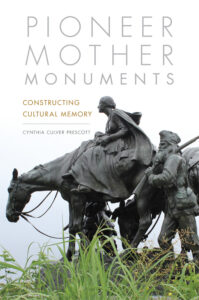Explores the history and significance of American pioneer statues
Pioneer Mother Monuments: Constructing Cultural Memory
Winner, Gita Chaudhuri Prize, Western Association of Women Historians
Winner, Fred B. Kniffen Book Award, The International Society for Landscape, Place & Material Culture
Honorable Mention, Armitage-Jameson Prize, Coalition for Western Women’s History
By Cynthia Culver Prescott
University of Oklahoma Press
Available Now!
 For more than a century, American communities erected monuments to western pioneers. Although many of these statues receive little attention today, the images they depict—sturdy white men, saintly mothers, and wholesome pioneer families—enshrine prevailing notions of American exceptionalism, race relations, and gender identity. Pioneer Mother Monuments is the first book to delve into the long and complex history of remembering, forgetting, and rediscovering pioneer monuments.
For more than a century, American communities erected monuments to western pioneers. Although many of these statues receive little attention today, the images they depict—sturdy white men, saintly mothers, and wholesome pioneer families—enshrine prevailing notions of American exceptionalism, race relations, and gender identity. Pioneer Mother Monuments is the first book to delve into the long and complex history of remembering, forgetting, and rediscovering pioneer monuments.
Historian Cynthia Culver Prescott combines visual analysis with a close reading of primary source documents. Examining some two hundred monuments erected in the United States from the late nineteenth century to the present, Prescott begins her survey by focusing on the earliest pioneer statues, which celebrated the strong white men who settled—and conquered—the West. By the 1930s, she explains, when gender roles began shifting, new monuments came forth to honor the Pioneer Mother. The angelic woman in a sunbonnet, armed with a rifle or a Bible as she carried civilization forward—an iconic figure—resonated particularly with Mormon audiences. While interest in these traditional monuments began to wane in the postwar period, according to Prescott, a new wave of pioneer monuments emerged in smaller communities during the late twentieth century. Inspired by rural nostalgia, these statues helped promote heritage tourism.
In recent years, Americans have engaged in heated debates about Confederate Civil War monuments and their implicit racism. Should these statues be removed or reinterpreted? Far less attention, however, has been paid to pioneer monuments, which, Prescott argues, also enshrine white cultural superiority—as well as gender stereotypes. Only a few western communities have reexamined these values and erected statues with more inclusive imagery.
Blending western history, visual culture, and memory studies, Prescott’s pathbreaking analysis is enhanced by a rich selection of color and black-and-white photographs depicting the statues along with detailed maps that chronologically chart the emergence of pioneer monuments.
Cynthia Culver Prescott is Professor of History at the University of North Dakota. She is the author of Gender and Generation on the Far Western Frontier and numerous articles on western history, anthropology of commemoration, and quilt studies.
Commentaries by Cynthia Prescott:
Why (Some) Monuments Get Removed
The Short Rows (Agricultural History Society blog) June 3, 2022
The monument controversy nobody is talking about
Washington Post May 26, 2022
Columbus Day marked a key battle in the History Wars of the 1990s: Clashes helped shatter old myths — but did they produce lasting change?
Washington Post October 11, 2021
(Text also available via History News Network)
Guest Commentary: Problematic pioneer statues deserve the same scrutiny as Confederate monuments
Think Confederate monuments are racist? Consider pioneer monuments
The Conversation August 7, 2018
Other Articles and Books by Cynthia Prescott:
“Looking Globally at Monuments, Violence, and Colonial Legacies,” with Janne Lahti, Journal of Genocide Research 24, no. 4 (2022). Introduction to Special Issue on Colonial Violence and Monuments in Global History.
“Myth, Memory, and the Limits of Inclusivity in Arizona Pioneer Monuments,” Journal of Arizona History 62, no. 2 (Summer 2021).
“This is the Place Salt Lake City, Utah and the Voortrekker Monument Pretoria: monuments to settler constructions of history, race, and religion” with Nathan Rees and Rebecca Weaver-Hightower, Safundi 22, no. 1 (2021).
“Enshrining Gender in Monuments to Settler Whiteness: South Africa’s Voortrekker Monument and the United States’ This Is the Place Monument” with Nathan Rees and Rebecca Weaver-Hightower, Humanities 10, no. 1 (2021).
Backstories: The Kitchen Table Talk Cookbook, Cynthia C. Prescott and Maureen S. Thompson, eds. (Digital Press at the University of North Dakota, 2021). Available as a free e-book.
“Going Digital to Enrich Research and Engage the Public,” California History 97, no. 1 (Spring 2020): 60-64.
“Enshrining Racial Hierarchy through Settler Commemoration in the American West,” in Monument Culture: International Perspectives on the Future of Monuments in a Changing World, edited by Laura A. Macaluso (Rowman & Littlefield, 2019): 49-59.
“Settler Colonialism and the Persistence of Pioneer Myths in Western Monuments, 1890-Present,” Journal of the West. Special issue on Settler Colonialism and the American West, ed. Janne Lahti. 56, no. 4 (Fall 2017): 78-89.
“Pioneer Mothers for the New Millennium,” in Excavating Memory: Material Culture Approaches to Sites of Remembering and Forgetting, edited by Maria Theresia Starzmann and John R. Roby (Gainesville: University Press of Florida, 2016), pp. 172-98.
“Representing the Ideal American Family: Avard Tennyson Fairbanks and the Transformation of the Western Pioneer Monument.” Pacific Historical Review 85, no. 1 (February 2016): 110-42.
“The All-American Eternal Family: Sacred and Secular Values in Western Pioneer Monuments” in We Are What We Remember: The American Past Through Commemoration, edited by Jeffrey Meriwether and Laura D’Amore. Cambridge: Cambridge Scholars Publishing, 2012: 334-58.
Gender and Generation on the Far Western Frontier. Tucson: University of Arizona Press, 2007, 2016.